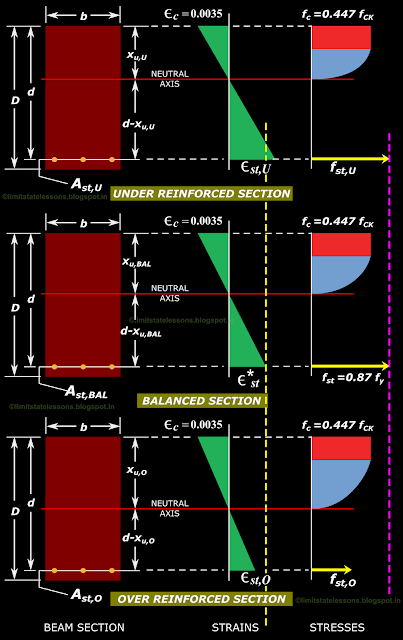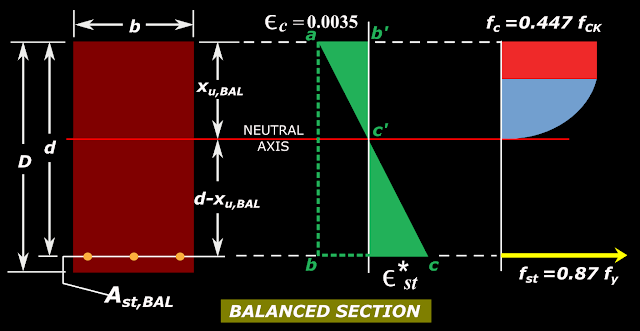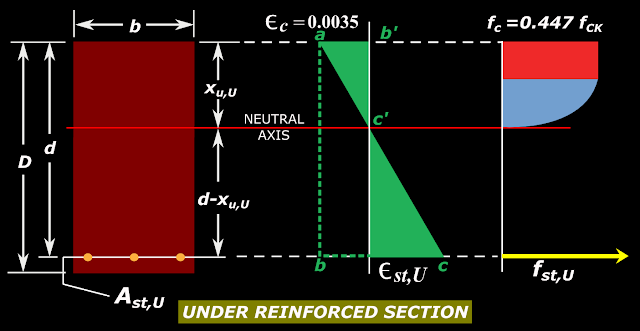In
the previous section we said that in a balanced section, during
the loading, the attainment of ultimate state in the topmost
compression fibre and the yielding of steel happens simultaneously. Before analyzing a balance section, let us show the features of all the three types in a single fig., so that they can be compared easily. Fig.3.25 below shows such a comparison between the three sections at the ultimate
state. For
convenience, we will assume that all the sections have the same grade
of steel, denoted as fy. So the combinations will be altered only by
the differences in area of steel.
Fig.3.25
Comparison between Balanced, Under reinforced and over reinforced sections
Let us see the various features of the above fig.:
• altitude of abc = ab = d
So we get
Eq.3.13
From the above equation, xu,BAL can be easily calculated because d is a given section property, and ε*st is a constant (Eq.3.12) given by:
In the above two equations, the only variables are d and fy. So we can make an important conclusion: All beams having a particular value of d and a particular grade of steel fy will be having a particular value of xu,BAL . In other words, if we are given any beam section, just by using it's d and fy, we will be able to say what it's depth of NA would be, if it were a balanced section.
Similarly, let us try to calculate xu,U the depth of NA of an Under reinforced section. For this, we will isolate the first row of fig.3.25 above:
Fig.3.27
Stresses and strains in an under reinforced section at ultimate state
Here also, using similar triangles, we will get:
Eq.3.14
But here we do not know the value of εst,U . We know that εst,U will be greater than ε*st . But the exact value is not known.
This same problem is present in the case of over reinforced beams also: Using similar triangles we will get
Eq.3.15
We know that εst,O will be less than ε*st . But the exact quantity is not known. So the above method of using the similar triangles is applicable to Balanced sections only. To find the depth of NA of Under reinforced and Over reinforced sections, we have to look for alternate methods.
But before we see those alternate methods, we will make an important inference. We have seen earlier (based on fig.3.22) that, when an Under reinforced beam is loaded to failure, the NA moves upwards. Similarly, when an Over reinforced beam is loaded to failure, the NA moves downwards. Also, we have discussed the reasons for these upward or downwards movements. We will get a mathematical presentation of this, if we arrange the strain diagrams of the three beams in a single row. So we will take the three strain diagrams of fig.3.25 and arrange them as shown in fig.3.28 below:
Fig.3.28
Comparison of strains
The
strain at the top most compression fibre is same in all the three
cases. In the case of balanced section, the strain graph which is the
line pq cuts the vertical axis at 'o'. In the case of under
reinforced section, pq will cut the vertical axis at a point above
'o' because εst,U > ε*st . In the case of Over reinforced sections, pq will
cut the vertical axis at a point below 'o' because εst,O < ε*st .
We know that the point where the strain graph cuts the vertical axis is the position of the NA because there, the strain is equal to zero. So the above fig.3.28 is a mathematical proof that:
• Depth of NA of an Under reinforced section will be less than that of a Balanced section and
• Depth of NA of an Over reinforced section will be greater than that of a Balanced section.
So some steps that can be done at the beginning of an analysis procedure of any given beam section can be out lined now:
When a beam section is given to us, we will be given it's
• width b,
• total depth D,
• effective depth d,
• Area of steel Ast,
• grade of steel (characteristic yield strength) fy, and
• grade of concrete fck.
The first step is to write down what it's depth of NA would be, if it were a balanced section. This can be done using eq.3.13 above. The only quantities we need are d and fy. We will denote this calculated value as xu,BAL.
Next step is to calculate it's actual depth of NA. If this actual depth is less than xu,BAL, then it is an Under reinforced section. If it is greater than xu,BAL , then it is an Over reinforced section.
But we have seen just now that the principle of similar triangles cannot be used for calculating the depth of NA of Under reinforced sections and Over reinforced sections. So in the next section we will see the alternate methods.
PREVIOUS
NEXT
Fig.3.25
Comparison between Balanced, Under reinforced and over reinforced sections
Let us see the various features of the above fig.:
• The
strain in concrete at the topmost compression fibre is 0.0035 in all
the three cases.
• So the stress in concrete at the topmost compression fibre is 0.447fck in all the three cases.
• The strain in steel εst,U for an under reinforced section is greater than ε*st .(εst,U falls to the right of the yellow dashed line which passes through ε*st)
• The strain in steel εst,O for an over reinforced section is less than ε*st.(εst,O falls to the left of the yellow dashed line)
• The stress in steel fst,U for an under reinforced section is equal to 0.87fy.(fst,U falls on the magenta dashed line which passes through 0.87fy)
• The stress in steel fst,O is less than 0.87fy in the case of Over reinforced section. (fst,O falls to the left of the magenta dashed line)
We have already seen how the above features will be obtained while conducting experiments on Under reinforced and Over reinforced beams.
For doing the analysis, we will now isolate the Balanced section in the middle row of the above fig.3.25. This is shown in the fig.3.26 below:
Fig.3.26
Stresses and strains in a balanced section at ultimate state
• So the stress in concrete at the topmost compression fibre is 0.447fck in all the three cases.
• The strain in steel εst,U for an under reinforced section is greater than ε*st .(εst,U falls to the right of the yellow dashed line which passes through ε*st)
• The strain in steel εst,O for an over reinforced section is less than ε*st.(εst,O falls to the left of the yellow dashed line)
• The stress in steel fst,U for an under reinforced section is equal to 0.87fy.(fst,U falls on the magenta dashed line which passes through 0.87fy)
• The stress in steel fst,O is less than 0.87fy in the case of Over reinforced section. (fst,O falls to the left of the magenta dashed line)
We have already seen how the above features will be obtained while conducting experiments on Under reinforced and Over reinforced beams.
For doing the analysis, we will now isolate the Balanced section in the middle row of the above fig.3.25. This is shown in the fig.3.26 below:
Fig.3.26
Stresses and strains in a balanced section at ultimate state
We
are going to use the principle of similar triangles. In order to
clarify the shapes, an imaginary line ab is drawn. So we have two
similar triangles: abc and ab'c'.
• altitude of abc = ab = d
• altitude
of ab'c' = b'c' = xu,BAL
• base
of abc = bc = 0.0035 + ε*st
• base
of ab'c' = ab' = 0.0035So we get
Eq.3.13
From the above equation, xu,BAL can be easily calculated because d is a given section property, and ε*st is a constant (Eq.3.12) given by:
In the above two equations, the only variables are d and fy. So we can make an important conclusion: All beams having a particular value of d and a particular grade of steel fy will be having a particular value of xu,BAL . In other words, if we are given any beam section, just by using it's d and fy, we will be able to say what it's depth of NA would be, if it were a balanced section.
Similarly, let us try to calculate xu,U the depth of NA of an Under reinforced section. For this, we will isolate the first row of fig.3.25 above:
Fig.3.27
Stresses and strains in an under reinforced section at ultimate state
Here also, using similar triangles, we will get:
Eq.3.14
But here we do not know the value of εst,U . We know that εst,U will be greater than ε*st . But the exact value is not known.
This same problem is present in the case of over reinforced beams also: Using similar triangles we will get
Eq.3.15
We know that εst,O will be less than ε*st . But the exact quantity is not known. So the above method of using the similar triangles is applicable to Balanced sections only. To find the depth of NA of Under reinforced and Over reinforced sections, we have to look for alternate methods.
But before we see those alternate methods, we will make an important inference. We have seen earlier (based on fig.3.22) that, when an Under reinforced beam is loaded to failure, the NA moves upwards. Similarly, when an Over reinforced beam is loaded to failure, the NA moves downwards. Also, we have discussed the reasons for these upward or downwards movements. We will get a mathematical presentation of this, if we arrange the strain diagrams of the three beams in a single row. So we will take the three strain diagrams of fig.3.25 and arrange them as shown in fig.3.28 below:
Fig.3.28
Comparison of strains
We know that the point where the strain graph cuts the vertical axis is the position of the NA because there, the strain is equal to zero. So the above fig.3.28 is a mathematical proof that:
• Depth of NA of an Under reinforced section will be less than that of a Balanced section and
• Depth of NA of an Over reinforced section will be greater than that of a Balanced section.
So some steps that can be done at the beginning of an analysis procedure of any given beam section can be out lined now:
When a beam section is given to us, we will be given it's
• width b,
• total depth D,
• effective depth d,
• Area of steel Ast,
• grade of steel (characteristic yield strength) fy, and
• grade of concrete fck.
The first step is to write down what it's depth of NA would be, if it were a balanced section. This can be done using eq.3.13 above. The only quantities we need are d and fy. We will denote this calculated value as xu,BAL.
Next step is to calculate it's actual depth of NA. If this actual depth is less than xu,BAL, then it is an Under reinforced section. If it is greater than xu,BAL , then it is an Over reinforced section.
But we have seen just now that the principle of similar triangles cannot be used for calculating the depth of NA of Under reinforced sections and Over reinforced sections. So in the next section we will see the alternate methods.
PREVIOUS
NEXT
Copyright ©2015 limitstatelessons.blogspot.com - All Rights Reserved




very well written article. Balanced and underreinforced section is an important topic to discuss. I am searching for these types of topics to read for a long time.
ReplyDeleteYou will find the same content on
Civil Experiences